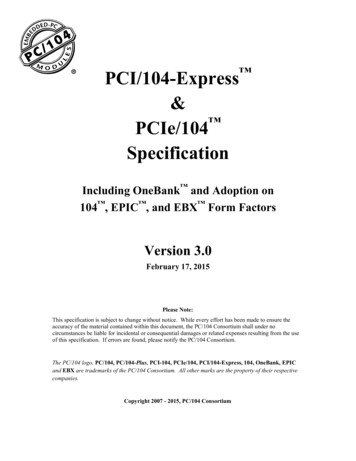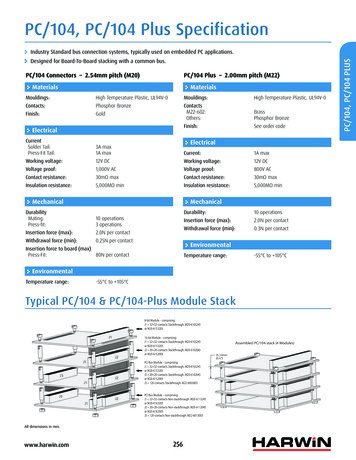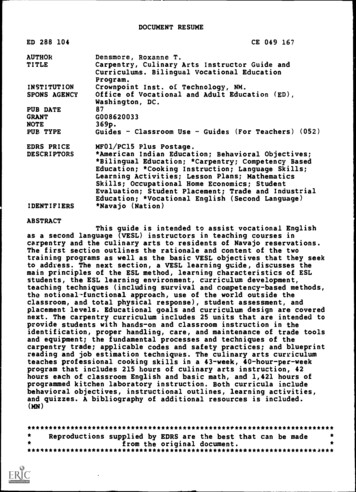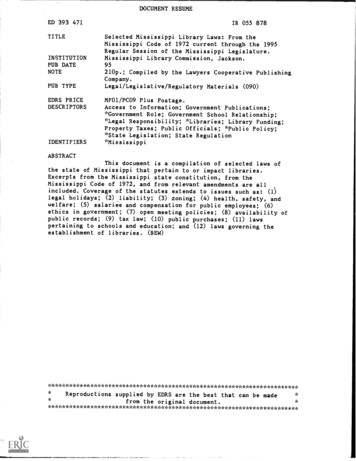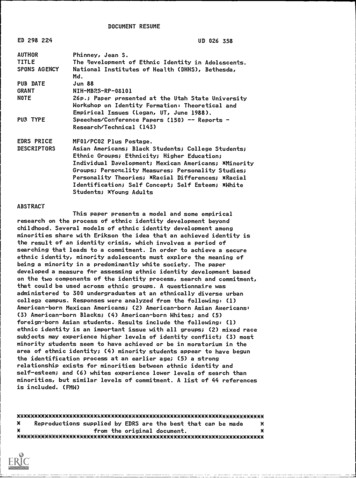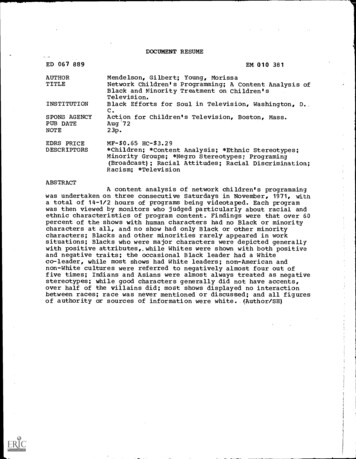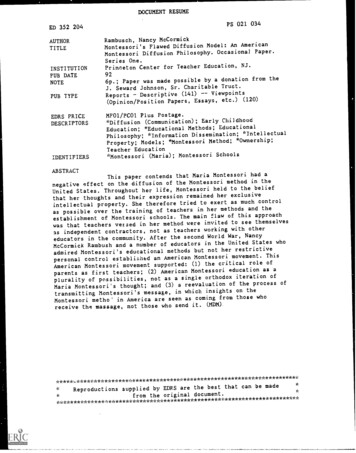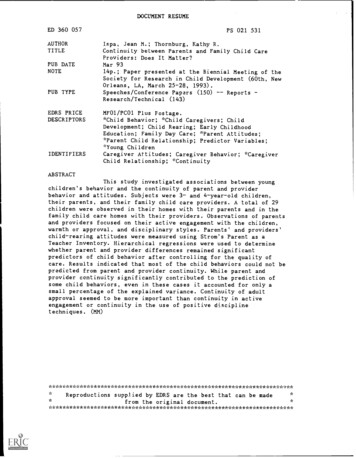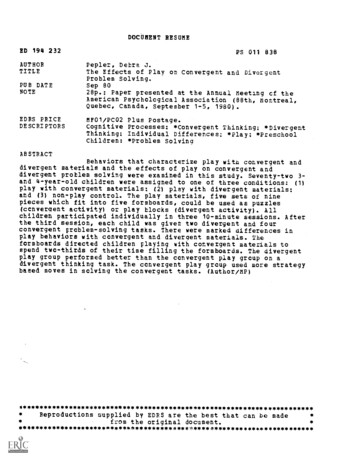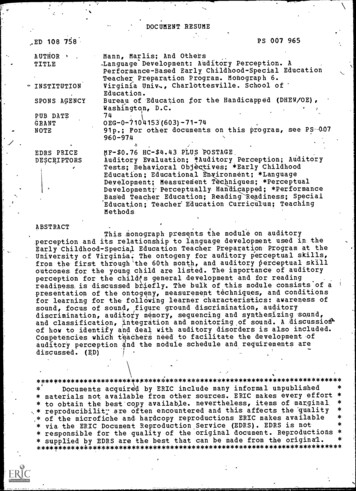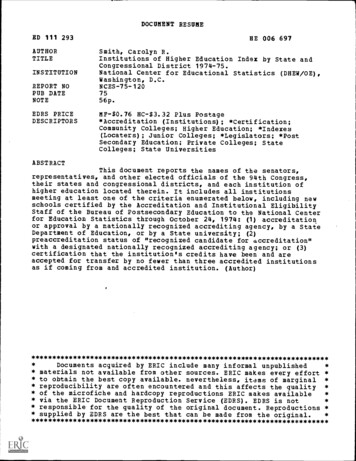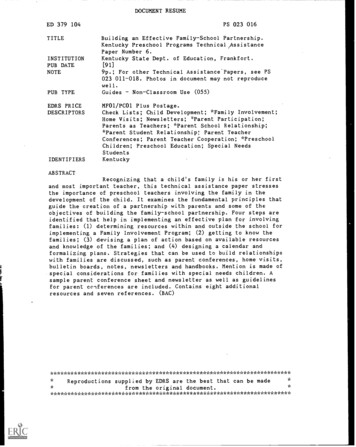
Transcription
DOCUMENT RESUMEPS 023 016ED 379 104TITLEINSTITUTIONPUB DATENOTEBuilding an Effective Family-School Partnership.Kentucky Preschool Programs Technical 1AssistancePaper Number 6.Kentucky State Dept. of Education, Frankfort.[91]9p.; For other Technical AssistancePapers, see PS023 011-018. Photos in document may not reproducewell.Non-Classroom Use (055)PUB TYPEGuidesEDRS PRICEDESCRIPTORSMF01/PC01 Plus Postage.Check Lists; Child Development; *Family Involvement;Home Visits; Newsletters; *Parent Participation;Parents as Teachers; *Parent School Relationship;*Parent Student Relationship: Parent TeacherConferences; Parent Teacher Cooperation; *PreschoolChildren; Preschool Education; Special g that a child's family is his or her firstand most important teacher, this technical assistance paper stressesthe importance of preschool teachers involving the family in thedevelopment of the child. It examines the fundamental principles thatguide the creation of a partnership with parents and some of theobjectives of building the family-school partnership. Four steps areidentified that help in implementing an effective plan for involvingfamilies: (1) determining resources within and outside the school forimplementing a Family Involvement Program; (2) getting to know thefamilies; (3) devising a plan of action based on available resourcesand knowledge of the families; and (4) designing a calendar andformalizing plans. Strategies that can be used to build relationshipswith families are discussed, such as parent conferences, home visits,bulletin boards, notes, newsletters and handbooks. Mention is made ofspecial considerations for families with special needs children. Asample parent conference sheet and newsletter as well as guidelinesfor parent conferences are included. Contains eight additionalresources and seven references. **************************Reproductions supplied by EDRS are the best that can be madefrom the original ******************************Ic
TECHNICAL ASSISTANCE PAPER NUMBER 6LL1L Of PARTNERI' OF EDUCATIONOpcs a Edvcatanal Rematc. and ININeveemmEDUCATIONAL RESOURCES INFORMATIONCENTER IERICI"PERMISSION TO REPRODUCE THISMATERIAL HAS BEEN GRANTED Byydocument nal WV, moroduc.d a.teco.ed Nom the IM,fon of of ganaoonG 0 tck sive wlN.c.mm .0C Mac( CI,IngreS Je been .40. to .rnOrOvtotOduCliOnOryln:SOlvte or oo.onf camp In th.decvmeal do not notattanty momsem eti.cmOEM pcx.i.on or oolocyCase ScenarioMs. Johnson was apprehensive during the summer which preceded her son'sparticipation in the local public school'snew program for four-year-old children.Jeremy W QS the first child in her family toenter public school and her friends knewlittle about the four-year-old program.Most had never been inside the elementary school some twelve miles away. Yes,size was excited about the idea of Jeremyriding the school bus and being so faraway. She would have no way to go tohim ilhe needed her. The famiiy day carehome where Jeremy stayed while sheworked, was operated by a woman shehad known most of her life, and she couldalways depend on the woman to let herknow if Jeremy had had a good day.Although Jeremy would return to theTO THE EDUCATIONAL RESOURCESINFORMATION CENTER IEPICCall the other children! A weekly newsletterhelped her know what unit Jeremy waslearning about at school, wizen she neededto send materials for activities, and evenhelped her learn some of the songs Jeremybrought home from school. She describedJ erezny's progress and suggested somechildren's bookswhich Jeremy might like forher to read with him at home. Ms. Johnsonhad not realized that by reading to Jeremy,she was helping him learn to read. Slit' alsoattended a parent meeting about guidingto take the gauzes to school and she was gladto help. Ms. Johnson knew she was being agood mother forJeremy and felt a part of hisfirst school experience.Introduction"Teachers who work to involve allfamilies recognize that even though they, asteachers, hold a special place in the lives ofchildren, it is the youngchild's family whichchildretz's behavior. The ideas really helpedwhen Jeremy teas so stubborn about dressing for school on time! Because she workedduring the day, she had little time to spendas a volunteer helping in the classroom, butplays the most critical role in the child'sslit' had been able to make some simplegames at home whiclz Ms. Patrick neededfor the children. Jeremy had been so pleasedopment of the young child. Current re-development for within each family are thechild's first and most important teachers"(Springate, 1991, p.271. As professionals,we have long recognized the invaluable rolewhich parents play in the growth and devel-search continues to establish the criticalimportance of the role of parents in thefamily care home fOr part of the day, whowould tell her about his experiences atschool?Fortunately, Ms. Johnson's concernsnd questions were acknowledged. Luring the summer, Jeremy's teacher, Ms.atrick, sent Jeremy a note to let himknow how much she looked forward to hiscing in her classroom in the fall. Shevet came to visit before school started .5()she could get to know Jeremy and hisnother. Ms. Johnson attended a parentorientation meeting at the beginning ofchool and met other families and learnedmore about the "hands -on" activitieshick Jeremy would be doing at school. Itwas amazing how much Jeremy wouldam by playing with blocks, paints, andMost interactions with parents are informed SUM as the interaction that occurs when parentbring and pick up children front the classroom.2BEST COPY AVAILABLE
educational process. In the forward of Becoming a Nation of Readers: The Report ofthe Commission on Reading (1985), Robert Glaser noted, The parent and the homeenvironment teach the child his or her firstlessons and they are the first teacher ofreac. -g too" (p.vi.).Under the best of circumstances, therole of the family in the growth and devel-Guiding PrinciplesThere are several very fundamentalWith these principle; in mind, theprinciples which must be incorporated intoplans for becoming"partners with parents".These principles are as follows:building of the family-school partnership1. The period of life from birth throughage five is most significant in terms ofdeveloping a positive self-esteem,opment of the young child can be over-positive attitudes toward schooling, andthe ability to engage in positive socialwhelming. The family is responsible for:assuring that the child's basic needs aremet;acquiring preventive health care as wellas care when the child is ill;securing appropriate and safe child care,detecting possible delays or abnormalities in development, seeking appropriate services for the child, and serving asan advocate for the child;interactions.This time is truly a"foundation" for the child's life.2. Education involves the TOTALCHILD.Schools and parents must addressphysical, cognitive, social, creative andemotional strengths and needs.3. It is essential that detection of potentialdevelopmental delays or disabilities andappropriate intervention strategiesoffering a home environment condu-occur at the earliest possible time in thecive to learning and being responsive tochild's life, rather than waiting for thechild to reach the primary grades. Earlydetection and intervention may preventthe child's needs for guidance, consistency, and support;nurturing the child's self-esteem; andretention, placementin specialeducation classrooms, and a child'sserving as a positive role model for livingand learning.These responsibilities may fall on family members who have little preparation forparenting and few resources to assist themin this tremendous responsibility.Formany, the task if parenting often leads to asense of failure and frustration not only forthe adult, but for the child who does notmeet the demands and expectations of theparent.Objectivesultimate sense of failure.4. Families who have low income levelss'ould not he characterized ashas many objectives including, but notlimited to, the following:1. acquiring information from the familyrelative to theirconcerns about the child,the program, and their role in the child'sgrowth and development;2. buildingthe rapport with families whichwill support effective long-term communication;3. agreeing upon a plan of action for thetype ofprogram, activities, and guidancetechniques which address the strengthsand needs of the child at home and atschoo:;4. informing families about the types andpurposes of activities in which the childwill participate;5. empowering families in their rolethrough information relating toparentingtechniques, health and safety,community resources, and basic childdevelopment; and6. utilizing the skills of the family as re-sources for the classroom and school(Hendrick, 1988).incompetent or uncaring with respectto the care and educational needs oftheir children.5. Families and children must be treatedwith respect.6. Teachers must observe professionalethics in discussing the characteristics,strengths, and needs of individualfamilies and children. Only when theThe Basics OfInvolving Familiesfamily's right to privacy is observed willtrust he established and communicationachieved.7. Being "at-risk" because of income leveldoes not determine that the child willTeachers can offer the family supportwhich will assist them in meeting the needsof their children and in feelin- good abouthave educational or learningdisabilities.8. The child who is at risk for educationalthemselves as parents. The dealthy selfesteem of the child is a reflection of thedisabilities is like all children in his/herneed for love and acceptance, positiveself-esteem, and feelings of success.healthy self-esteem ofthc parent. The familycan serve asa valuable resource in providinginsight about the child and his/her homelife which will assist the teacher in planningappropriate instructional strategies for eachchild. EFFECTIVE TEACHING CANNOTOCCUR IN ISOLATION OF THECHILD'S FAMILY.difficulties or who has identifiable9.Regardless of being labeled "at-risk",having disabilities, or being a typicallydeveloping child, ALL CHILDRENLEARN BEST THROUGH PLAYWITH CONCRETE MATERIALS(Hendrick, 1988).The importance of the child's pun!y must berecognized befOre a program can adequately meetthe needs of the child.2BEST COPY AVAILABLE3
StrategiesThere are many strategies which can beutilized in involving families. In the opening scenerio, the teacher, Ms. Patrick, clearlymade attempts to involve Jeremy's motherin the life of her young child at schoolthrough a variety of one-way communication techniques, such as notes and newslet-ters, and two-way communication techniques, such as home visits, parent orientation andinformation meetings, and parentconferences. By involving Ms. Johnson inthe simple task of making games, Ms. Patrickprovided an opportunity for the parent toexperience a sense of worth by making aneeded contribution to her son's classroom.Successful and meaningful family involvement activities do not simply happen.They should he carefully planned with re-gard to specific objectives, needs of thefamilies, and resources available. Considerthe following general steps to prepare toimplement an effective plan for involvingfamilies.STEP 1:Determine Resources for Implementing aFamily Involvement ProgramExplore resources within the school community. A district reference library maybe available with pertinent resourcematerials. If not, check the local publicand university/college libraries. Talkwith other teachers who actively involvefamilies for their suggestions. Discussideas with a supervisor.Explore print materials provided withinthe journals and publications of professional organizations. The National As-sociation for the Education of YoungChildren (NAEYC) publishes excellenthooks, pamphlets, and a journal entitledYoung Children. The Council for Exceptional Children (CEC) also publishesa useful journal entitled Teaching Exceptional Children. The Southern Association on Children Under Six (SACUS)also has excellent materials available inthe journal, Dimensions. The local affiliate of SACUS, KACUS, publishes anannual journal, Kaleidescope, which mayalso be helpful.Visit your Early Childhood RegionalTraining Center to view the wealth offamily support information housed intheir library or with a Parent ResourceCenter. Professionals on staff can alsoprovide resources relative to parent education models and additional school andcommunity resources. A supervisor canprovide information relative to the loca-tion and staffof the local Regional Training Center.Research community resources such asthe library, health department, Comprehensive Care Centers, Departmentof Social Services, and Kentucky Department of Education, which might beof assistance in providing informationabout resource persons, local workshops,and print materials.Talk with instructors who teach coursesrelative to family involvement at localcolleges and universities. Such coursesare generally housed in the areas of HomeEconomics or EducationSTEP 2:NewslettersNotes or Happy GramsFamily Social EventsInformal contacts with families via dailyface-to-face and phone conversations.STEP 4:Design a calendar in accordance with theschool policies and procedures and formalize plans with an appropriate supervisor.Techniques ForInvolving FamiliesKnow the FamiliesDetermine the composition of the fam-Employ a variety of strategies in effortsily. (For example, the child's parent(s)to build home-school relationships withfamilies. Those involving two-way com-may be one or both natural parents,adoptive, or foster parents; grandmotherand/or grandfather; uncle and/or aunt;or an older sibling who has assumed theparenting responsibility for the child.)Also determine the number and ages ofother children in the home. The familymay have preconceived notions aboutschool through the experience ofan olderchild. It may he necessary to explore. child care options for children requiringsupervision during parent meetings andconferences.Consider the job responsibilities of family members. If both parents are employed during the day, make home visitsand plan other parent activities in thelate afternoon or evenings. Find alternate ways for these families to serve asclassroom resources. Be sure to makeevery attempt to include both mothersmunication, such as parent conferences andhome visits, are most effective as both parent and teacher actually experience the reactions ofthe other. Both parties, the teacherand the family, have an opportunity tolisten and to express needs, concerns,thoughts, and feelings. Specific techniqueswill be presented later in the document forplanning and implementing the followingstrategies characterized by two-way corn munication: home visits, parent meetings,parent conferences, and parent volunteerprograms.In methods involving one-way communication, the teacher or person providing information is unable to see or determine the responses of the parent or personreceiving the information. While not aseffective, these methods are necessary because it is not feasible to talk with all parentsand fathers.Determine the number of families whocould provide their own transportationto school events. Carpools may he aconsideration.on a daily and perhaps even weekly basiswhen children are transported by bus toschool. Strategies will he presented later inthe document for these techniques, whichKnow the fam ilies with respect to educa-grams, and handbooks.include: bulletin boards, newsletters, happytional experiences, opportunities, andcapabilities.I lone VisitsSTEP 3:Using resources available, knowledge ofthe families, and input from the familiez:,devise a plan of action for the school year.It should include:Home VisitsParent ConferencesParent/Family Bulletin BoardParent Information MeetingsHandbookFamily Volunteer Program4A home visit is an e:i.cellent tool forbuilding rapport with the family early in theschool year and the first visit should beconducted before school starts or withinthe first 60 days. Visits should continue ona regular basis throughout the year. Theteacher has an opportunity to get to knowboth the parent and child in the homesetting where family members are mostcomfortable. In this non-threatening envi-3
6.Offer suggestions for parent-childactivities which are inexpensive andinvolve lots of parent-child verbalinteraction. Stress the importance ofreading with the child daily.Encourage the parent to describe his/her needs as a parent.8. Admit you do not have all the an.swers, but attempt to locate appropriate information.9.During the visit:request the television he turnedoff;ask for a set space for workingThe teacher establishes the classroom climate that encourages parents to participate. Here a parentassists an activity that is fiin and creative.ronment, the family should feel more comfortable in asking questions and expressingconcerns about the upcoming school experience. Every effort should he made toschedule the visit when both parents, ifappropriate, are at home. Visits will need toaccommodate the work schedules Of thefamily member( s) responsible for the child.Keep in mind the home visit serves abroader purpose than the completion ofschool records. in addition to establishingrapport with the family, the home visitaffords the teacher an opportunity to get toknow the child so the child will be morecomfortable in coming to the school and sothe teacher will know something about thetypes ofactivities which might suit the ch ild'sneeds. The home visit also provides anDuring your visit you can read thebook or ask the parent to read the book withthe child if the parent or family member iscomfortable in doing so. You can engagethe child in the game or puzzle and inengage in simple learning activities with thechild at home.In preparation for the home visit, develop a home visit kit. A basket or box witha cover or lid is helpful for transportingmaterials and keeping materials out of thechild's view until you are ready to use them.As an ev.n ple, place the following materials in the basket.a camera (You may want to preparethe parent for picture-taking activi-t ure of his/her new school. ) These activitieswill give you some idea of the child's previous experiences and interest in books, feelings about going to school, attention spanThe parent meeting may be plannedfor the specific purpose of orienting parents to the school program, providing information to assist families in enhancing,parenting skills, or as a social occasion tocelebrate a holiday or important schooland fine motor and problem solving skills.While the child is working with materials,you can talk with the parent about thecoming year. If you have brief, printedinformation about your program, youmight like to leave the material with thefamily.Before' leaving, taka' a picture of thechild at home which you can display in yourclassroom during the first weeks of school.The pictures help other children get to knowtheir new friends and help each child feelmore comfortable in the new setting. Leavethe ball of dough as a reminder of a fun visitand things to come at school.As visits are made throughout the year,consider the following guidelines:convenient days and times for meetings,nee for child care,transportation difficulties, andtopics of critical importance.This assessment can be conducted verbally as teachers talk with parents and makehome visits or in printed questionnaire for-mat. If a printed questionnaire is chosen.keep it simple and brief so that parents doI.Accept the famih and the home.not need to spend a great deal of timeAssess the existing skills of the parent3.and build on those skills.Build parent confidence by offeringwriting. This will help to assure the returnof the fOrms. In planning a patent education meeting, list several topics suggestedhonest praise and positive su
TITLE Building an Effective Family-School Partnership. Kentucky Preschool Programs Technical 1Assistance Paper Number 6. INSTITUTION Kentucky State Dept. of Education, Frankfort. PUB DATE [91] NOTE 9p.; For other Technical AssistancePapers, see PS. 023 011-018. Photos in document may not
